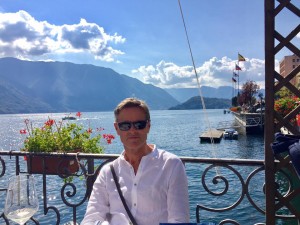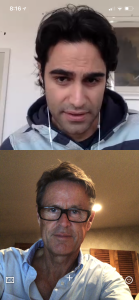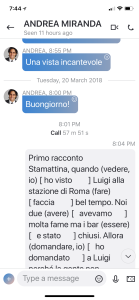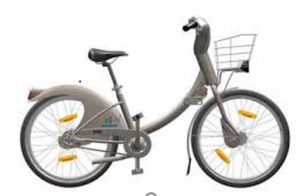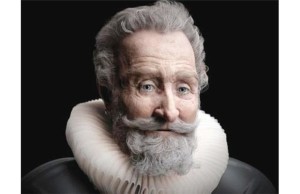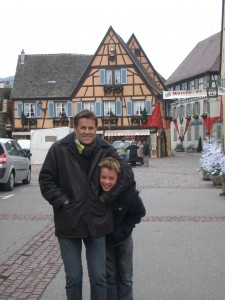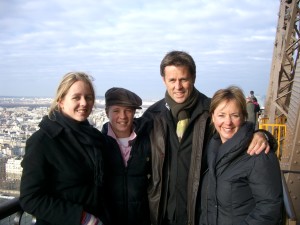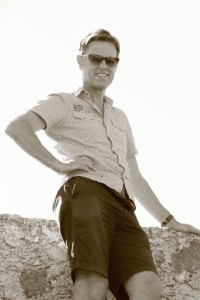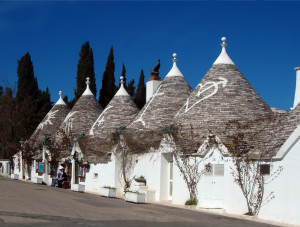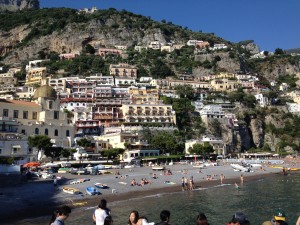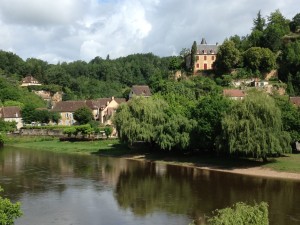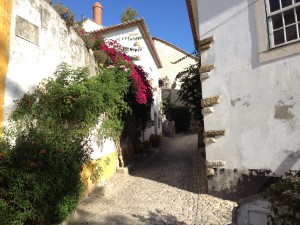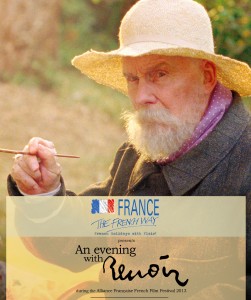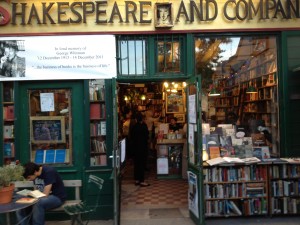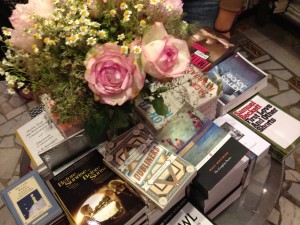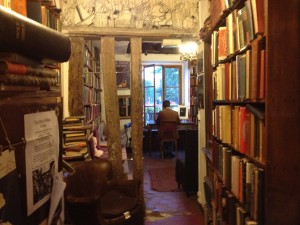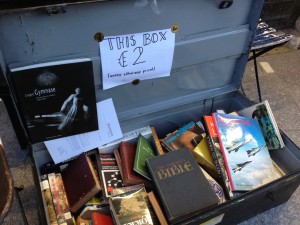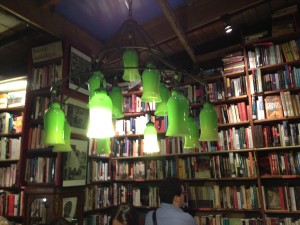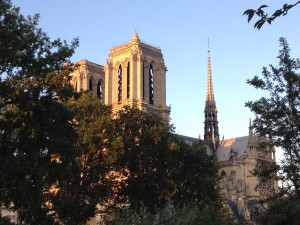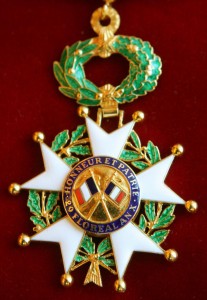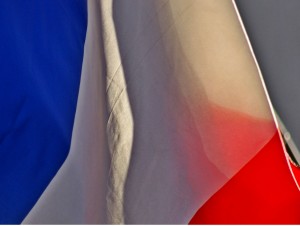It’s been a long-held ambition of ours to do a canal boat cruise in Europe, preferably in France. Recently, we bit the bullet, burnt our bridges and booked the boat. In late September, we set off for France, and the Locaboat depot. We traveled via Bordeaux and the Gironde region, a beautiful wine-growing region full of charming little villages and marvelous cafés.
We dropped our car in Carcassonne, having decided to take a train from there. This gave us the opportunity to have a lovely little incident on the Carcassonne railway station. I went to the toilet, which was one of those little round jobs which you feed 30 cents to get in. There was an English woman in there before me, and her husband decided to hold the door open for me so I could have a free pee. Unfortunately, this meant I ended up inside the locked pissoir, being drenched by the washing process. I quickly got out, only to find the machine swallowed my 30 cent piece and wouldn’t let me back in! Eh bien, fortunately the train had a very nice toilet.
We took the train from Carcassonne to Lézignan-Corbières, and then taxi ride to Argens-Minervois, where we took delivery of our boat, Ognon. Not to be confused with oignon (onion), this dear little tub is named after one of the locks we passed through on our trip. After some documentation, unpacking and a training course with the technician, we set off for Homps. 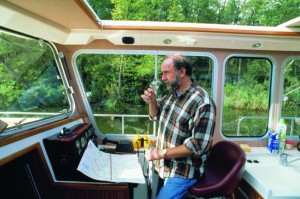
In no time, we were at the first lock, a double. They say the first one is always pretty terrible, and it certainly was interesting with only two of us on board. When you’re going “uphill”, one person has to get off before the lock, and race up to catch the ropes from their boat. For us, this left my poor husband to drive the boat into a restricted space, bring it alongside, then turn it off and run for the bow to throw up the front rope, then career down the blunt end to throw the second rope. The person on the bank has to loop these around bollards, somehow controlling both, although they are several metres apart!
Fortunately the boat in front was full of friendly Czechs, who came to our rescue and helped us through. By the time we hit lock number three, we were getting the hang of it and I was chatting to lock keepers as I flung ropes around the place. I have a sneaking suspicion that there was more than a hint of Officer Crabtree (‘Allo ‘Allo) in my Gallic gossip, but the lock keepers managed to smother their mirth. By this time, the husband was handling the boat like a seasoned pro.
We tied up at Homps for the night. The ports are full of boats, with people sitting out having a wine, or strolling up and down the waterside, having a look at each others’ boats. The waterfront at Homps is lined with restaurants. We chose to go into one that was a bit set back and not so obvious. It was filled with French people – a good sign. And so it proved to be – a deliciously fragrant and tasty cassoulet au confit de canard was downed by both of us with contented sighs and the help of a robust red from the region.
The bells of Homps are mysterious in their ways. They chime the hour and half hour during the day in the regular way of bells, but at night and at 7am, they perform a joyous romp through what sounds like a children’s nursery rhyme with more than a touch of nar ne nar ne nar nar about it.
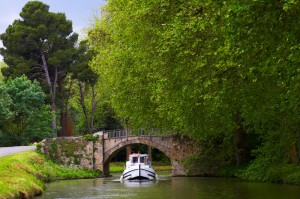 Homps is an old town, with narrow streets and stone buildings – homes right on the street with bright coloured shutters. We bought provisions there, riding back to the boat on our bikes, with baguettes and wine in the basket on the handlebars. We then sat at the little table in the bow and had baguettes, jam and cafe au lait. It was getting perilously close to paradise…………..
Homps is an old town, with narrow streets and stone buildings – homes right on the street with bright coloured shutters. We bought provisions there, riding back to the boat on our bikes, with baguettes and wine in the basket on the handlebars. We then sat at the little table in the bow and had baguettes, jam and cafe au lait. It was getting perilously close to paradise…………..
From Homps to Trèbes was quite a haul, with lots of locks. We took turns at driving the boat, and taking exercise along the towpath at the side of the canal. I say this insouciantly, but my first driving experience was not without its entertainment – for the other boaties at least. I managed to maneouvre the boat so it was right across the canal, from bank to bank, with a lot of shouting which owed more to the Anglo-Saxon tradition than the Gallic.
Once you’ve finally got it, driving along in the boat is quite soporific – you cruise along a watery avenue lined with chestnuts, oaks and sometimes pines, and often they form a complete canopy overhead. I’m sure the first architects to design ribbed vaulting in churches must have been inspired by such a sight.
After a pause for salad and rosé on the boat for a late lunch, we made it to Trèbes in time for the last lock, and moored there for the night – slightly out of town. There are huge tree roots along the canal, and they make very good mooring points, so you can tie up wherever you feel like it. We explored Trèbes on our bikes for a while, then went to Moulin de Trèbes, situated right on the lock, for dinner. Wandering back along the canal, we stopped and chatted to people in their campervans – people from all over the place, and all very friendly.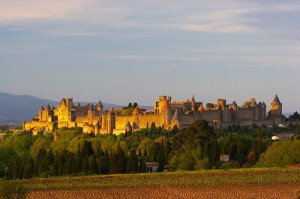
Next stop was Carcassonne, scene of my triumph with the French toilet system. We tied up at about 3pm, having yet another late lunch accompanied by rosé, and talking with various people who came by. One of them was a Frenchman who had shared locks with us during the day. We ended up having about a 15 min conversation in French! The husband swears he could hear my brain ticking, but we seemed to make ourselves understood to each other! On the other hand, we could have been talking about two completely unrelated matters……
The next morning, we were invited to the next door boat for coffee. It was a couple who have been living on their boat for about 3 years since they retired. He is retired English naval engineer and she is German. Every now and then they leave their boat moored, and go off to England or somewhere for a break, but then they come back and pick up their nomadic life. They’ve been all over Europe, and really love living on the canals.
After coffee, we called in to see some English people we’d met, intending to stay for a few minutes before going up to the old city again. Two hours and 2 bottles of very fine vin de pays later, we wobbled up the steep hill to the old city on our bikes, and had a look at the lovely old (like 1600 years old) Basilica and other buildings, ramparts, battlements, and the other things you have in your grade one medieval village. It was very interesting, with marvellous views out over the rest of the city and surrounding countryside. We had to have lunch and beaucoup d’eau to water down the wine so we could be trusted hurtling back downhill to the boat.
This is kind of how it is on the canal – time becomes a bit meaningless. The locks close at a particular time but, if you don’t make it through, you just tie up and wait for the morning. People are really friendly, and keen to get to know you, and getting to know you is a process generally accomplished over a bottle of wine.
Carcassonne was our turnaround point, and mid-afternoon we set off back to Trèbes, where we found the town was shut because it was Monday. In France, that’s a perfectly good reason. We biked into town the back way, meeting both Australian and New Zealand boaties on the way. We found a little backstreet cafe, which was really nice and a bit less touristy, then lurched back through the dark on our bikes – a few interesting moments in loose gravel, not helped by the bottle of Domaine de La Roque we’d consumed. The lovely thing about French wine – even when it’s a rough red, it SOUNDS really good. As does Langue de Boeuf, which the husband ate that night – sounds much more appetizing than beef tongue, doesn’t it?
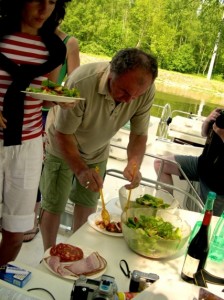
Lunch on Board our Canal Boat.
Boating into and out of Trèbes, you are escorted by the swan. A graceful white beast with exquisite manners, it seems to know that boaties love their baguettes fresh, so it’s there to help with recycling the day-old stuff. It’s worth feeding it, just to watch it angle down graciously to pick up the bread from the water. The ever present ducks are another matter. After a few mornings of waking up to the sound of them squabbling as they clean the side of your boat, the words duck and confit just seem to fit naturally together.
Cruising back down towards Homps, we stopped and looked at small villages on the way. We shared the locks with two boats full of what we took to be English people, and one German couple in a tiny fizz-boat. He was rotund of belly and red of face, and wore a large straw hat. She was willowy with masses of blonde curly hair, and didn’t seem to mind when he barked orders at her. The little boat had a green sun umbrella on top, and looked for all the world like a little cocktail floating down the canal in between penichettes and barges.
We moored between locks at Puichéric that night, and got on our bikes to explore the village for a restaurant. As we biked over the bridge, we were called to the two boats we’d shared locks with, which contained a party of 9 residents of Guernsey – Guerns, they call themselves. Onto a boat we clambered, and got to know them over some muscular gins, then a reconnaissance party arrived back to say they’d found a restaurant. Invited to join them, we found ourselves at a table of 11, stretched right across the tiny restaurant, and having a wonderfully noisy evening. Yet another wobbly ride back through dark roads – fortunately, these little roads have little or no traffic on them!
We stopped at Homps long enough to pick up some supplies, including some clothes pegs which took no end of ingenuity for me to explain to the shopkeeper. For future reference, they are known as minces de ligne. We then set sail for Ventenac-en-Minervois, further east from our pick up and drop off point. The canal is very beautiful on this stage – tree-lined and tranquil, with vineyards stretching out to blue-purple mountains in the distance, the occasional tower or small village coming into view. I negotiated with some trepidation the narrow bridge Pont-Canal de Répudre, built by Riquet, the original designer of the Canal de Midi, in the seventeenth century. 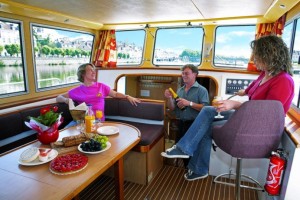
We arrived at Ventenac at about 6pm, to find it was closed on the Wednesday. Tant pis, we had our supplies on board, including a rabbit pie that I had been unable to resist buying in Homps, so we were very happy to eat on the canal, with the water lapping at the sides of the boat, and the soft light of southern France fading gently. As it faded, black tree trunks stood out in relief, reflected in the still water, the hills smoky ink-blue, and the sky pearly. It was a magic night.
After a set of breakfast treats from the tiny boulangerie, we set off for Le Somail – our furthest point. It is a very pretty little town, with a floating épicerie, library, galleries and restaurants. We biked around the town and saw the Le Somail version of housewives – yet another Audrey Tatou and Brigette Bardot. The town was full of middle-aged English people obviously on a painting holiday. They were lined up along the canal with their folding chairs and easels, and there was certainly no shortage of material for them to paint.
Eventually, we headed back up the canal, stopping at Rubia for lunch, then traveling the short stretch to Argens-Minervois. We stayed just outside the town for the night, so that we could return the boat at the appointed time the next morning. We biked around the town, up into the old city, and out into the countryside a bit. This town was also closed, so we ate an odd assortment of food to finish up our supplies, and cleaned up the boat.
Dropping it off the next day was rather sad. We’d got very fond of our Ognon, and it felt like we were losing a friend when we took out bags off and drove away from the port. Altogether, we’d had a wonderful time, but we could have stayed longer. A week is enough time to get into the swing of canal boating, but not enough to really explore the region thoroughly on bikes or foot.
Often, you feel like you’re living a cliché. The bikes, the baguettes, the wines, the scenery – it feels like you’re in a movie filled with all the French stereotypes. You can take side trips, walk or bike along the tow road, you meet lots of people from different countries, you can read, sleep, or just sit there, watching the trees and vineyards glide by, inhaling the slightly rotten, sweet scent of the grape harvest, and dreaming.
If you are in danger of getting bored, there are always the locks, where you see drama and excitement – hell, sometimes you cause it! The lock-keepers are all different, mostly very pleasant, some surly. You can buy produce in the locks – honey, wine, fresh fruit and vegetables, and sometimes you can engage the keepers in conversation if you’re brave. And always you leave with an au revoir, merci, and get an answering wave.
Will I do it again? You bet – in a heartbeat! I can’t think of a better way to see a country.
With thanks to a happy traveller of mine for sharing her story with me.
Canards from the Canal du Midi
Diary of a Dilettante
Written by Paddy Austin, Christchurch, NZ
